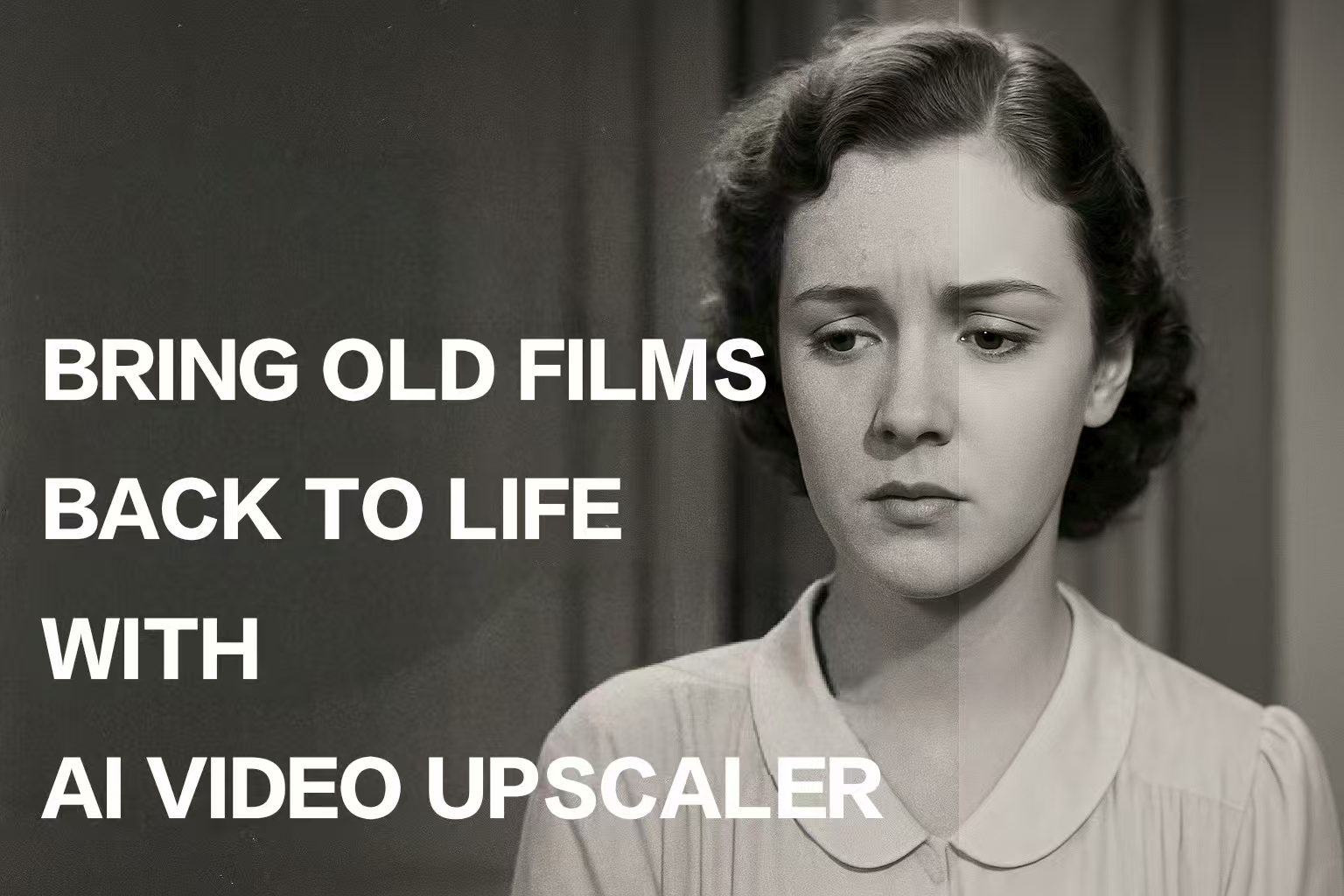Last Updated on September 4, 2025 by Leslie
Old films carry a unique kind of nostalgia—grainy textures, soft edges, and colors that don’t quite pop the way we expect today. Whether it’s a favorite VHS from the ’90s or a beloved early digital recording, these films remind us of the way we used to watch stories unfold.
But even movies from just a few decades ago weren’t made for the screens we use now. Low resolution, faded color palettes, and dated soundtracks make them feel… distant. That’s where modern restoration and enhancement tools come in. By improving clarity, color balance, and resolution, we can breathe new life into these classics—making them easier to enjoy without losing their original charm.
The Cultural Significance of Old Movie Restoration
Restoring classic films isnt simply about sharpening an image or fixing scratches. It is about preserving history — both cultural and artistic. Films serve as windows into different eras, reflecting the social values, fashion, architecture, and political climates of their time. They show us how storytelling, acting, and filmmaking techniques have evolved.
For viewers today, watching a restored classic is like stepping back in time. Restoration technology plays a pivotal role in this experience—improving resolution, enhancing clarity, and reviving the vibrant visuals that reconnect us with our collective memory and cultural identity. Without these tools, many of these cinematic moments would gradually fade away, lost to time and deterioration.
As a personal example, I am a devoted fan of Leslie Cheung , and it was only after his passing that I truly appreciated his artistry. The restored re-release of his film Moonlight Express gave me the chance to experience his charm and talent with fresh eyes. Seeing the film in its renewed quality during the restoration re-release made me realize how important film restoration is — not only preserving the film itself but also reigniting emotional connections across generations. For fans like me, restoration offers a second chance to discover and cherish cinematic treasures that might otherwise fade away.

The Harsh Realities of Film Decay
Physical film is a surprisingly fragile medium. Cellulose nitrate film, used until the early 1950s, is highly flammable and decomposes rapidly. Even more stable acetate films suffer from “vinegar syndrome,” a chemical degradation causing warping and brittleness. Colors fade unevenly, and scratches accumulate from repeated handling and projection.
Beyond physical damage, older films often suffer from technical limitations of their original production:
- Low resolution compared to modern digital standards
- Limited dynamic range leading to dark shadows or blown highlights
- Audio tracks recorded with primitive technology, making sound unclear or distorted
All these challenges make restoration a delicate blend of technical expertise and creative judgment. That’s where modern enhancement tools come into play—boosting resolution, balancing contrast, repairing visual flaws, and even improving audio quality. By combining these capabilities, restoration becomes more than just a fix—it becomes a chance to rediscover the film’s original character.
Traditional Film Restoration Techniques
Historically, restoring a film meant working directly with the physical reels. Specialists would:
- Clean the film meticulously to remove dirt, dust, and mold
- Repair tears and perforations by hand
- Digitize the film by scanning each frame at high resolution
- Manually correct scratches, color fading, and flickering frame by frame using digital software
- Restore audio through noise reduction, equalization, and re-syncing
This process could take months or years for a single film, demanding expert craftsmanship and enormous patience.
The Rise of Digital Restoration and AI Video Enhancer Tools
Digital technology revolutionized film restoration by allowing:
- High-resolution scanning to preserve every detail
- Software tools to automate defect detection and correction
- Color grading to restore original hues or improve faded palettes
- Audio remastering using digital filters and noise suppression
At the heart of these advances lies the video upscaler, a tool that merges technical precision with creative care. It excels in video upscale, leveraging high-resolution data to boost clarity and elevate older footage to modern standards, while acting as a powerful video enhancer — refining color grading, smoothing out defects, and complementing audio remastering efforts. Together, these capabilities help archivists bring forgotten classics back into public view, often on new digital platforms like Blu-ray or streaming services, ensuring the past’s cinematic voices remain vivid and accessible.
AI Video Upscaler: Promise and Limits in Old Film Restoration
Recently, artificial intelligence has entered the restoration arena. AI-based video upscalers and promise faster, more automated restoration workflows.
Using machine learning models trained on thousands of videos, these tools analyze frames and attempt to reconstruct missing details, reduce noise, sharpen edges, and even improve color fidelity. Some AI systems offer 4K upscaling, converting low-resolution footage into formats compatible with modern displays.
However, while the progress is exciting, it’s important to recognize current limitations:
- AI models still struggle with complex damage like heavy scratches, missing frames, or warping
- Results can sometimes look artificial or overly “clean,” losing the original film’s texture and atmosphere
- AI cannot yet replace human judgment on artistic choices such as how much color correction is appropriate
- The highest-quality restorations often blend AI tools with expert manual work
In short, AI tools are a powerful complement to traditional methods, but not a replacement for the nuanced work of professional restorers.
Why True Restoration Is More Than a Video Quality Enhancer
The goal of old movie restoration is not to make a film look like a modern blockbuster but to faithfully preserve and reveal the original vision. This often means retaining grain, scratches, and tonal qualities that give a film its character.
Blindly applying generic video quality enhancers risks erasing these qualities and turning historic works into something new and unfamiliar. The best restorations respect the source material’s soul while improving clarity and watchability.
Upscale Video to 4K: The Future of Film Restoration
As AI technology evolves, so too will its role in film restoration. Emerging techniques in neural networks and deep learning hold promise for addressing current challenges:
- Intelligent repair of missing frames
- Reconstruction of damaged or lost scenes
- More nuanced color and texture restoration that mimics original film stock
The collaboration between human expertise and AI innovation may open new frontiers, making restoration faster, more affordable, and available for a wider range of works — including home movies and independent films.
AI Video Enhancer 1080p Online Free for Everyday Use
While professional restorers rely on complex workflows, today’s enthusiasts and content creators can also experiment with simpler tools. For those looking to improve the quality of personal or archival footage, video quality enhancer 1080p online free platforms can offer meaningful improvements with minimal effort.
Although not a substitute for full restoration, these tools enable users to enhance video quality quickly, upscale resolution, and reduce noise, bringing new life to old family videos or shared clips. Popular software like the HitPaw Video Enhancer is a user-friendly option for those who want to try how to make video enhance AI faster and improve videos without needing professional skills.
Old movies are treasures that connect us across generations, and restoring them requires reverence, skill, and increasingly, smart technology. While true restoration remains a delicate craft, the arrival of AI video enhancers offers fresh hope that these stories can continue to inspire, educate, and move us for decades to come.
FAQs
Can I use GStory to enhance video quality or upscale old footage?
Yes, GStory is a web-based platform that offers powerful AI video enhancer tools. It’s perfect for users who want to improve old or low-quality footage — whether it’s a vintage home video, a blurry clip, or a social media post. You can enhance video quality, remove noise, and even upscale to 1080p or 4K, all online and without installing software. Plus, new users receive free credits to try out the features.
What’s the best AI upscaling free tool for restoring old videos?
For beginners or casual users, some of the best AI upscaling free tools include platforms like GStory and HitPaw Video Enhancer. These tools use machine learning to sharpen details, reduce noise, and even upscale old footage to HD or 4K. While they’re not a replacement for professional restoration, they offer a fast and accessible way to improve your old videos with just a few clicks.
Can I use an enhancer for YouTube videos?
Yes, an enhancer for YouTube can be useful for improving video quality before uploading or sharing content. AI-based tools help upscale resolution, enhance clarity, and even fix low-light issues — making your videos look more polished and professional. This is especially handy for older uploads or vintage footage you want to re-share.
How to make video enhance AI faster when dealing with long footage?
To make video enhance AI faster, choose platforms that support GPU acceleration and batch processing. Tools like HitPaw or GStory offer settings that optimize speed without sacrificing quality. Also, pre-trimming your video and working with smaller segments can help speed up the enhancement process, especially for long or heavily damaged footage.
Can I do 4K upscaling for old home videos using AI?
Absolutely. Many AI tools today offer 4K upscaling for personal videos, allowing you to transform standard-definition or blurry footage into higher-resolution versions. Whether you’re working with old family tapes or vintage digital clips, upscaling can enhance details and make your videos look great on modern screens.
